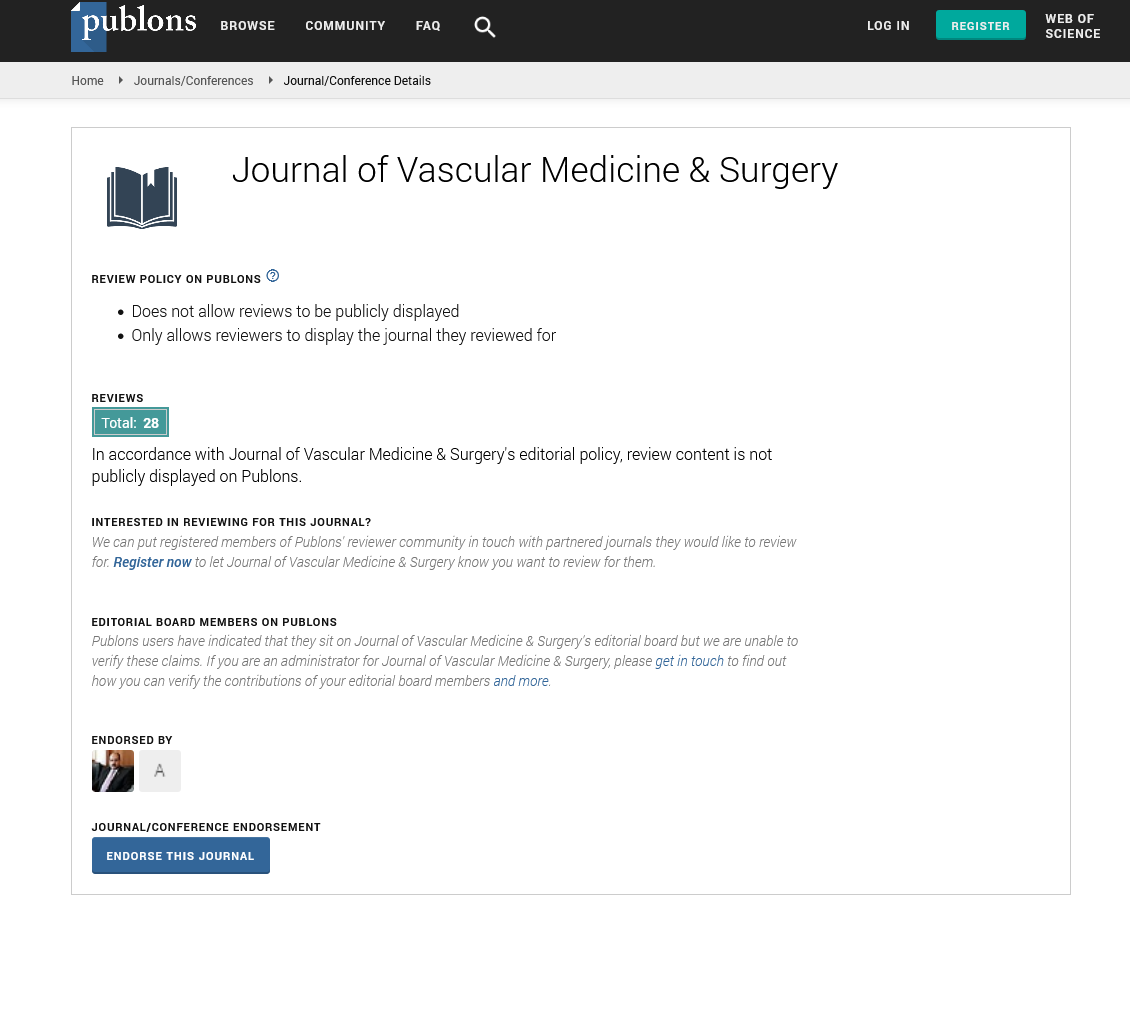Indexed In
- Open J Gate
- Academic Keys
- RefSeek
- Hamdard University
- EBSCO A-Z
- OCLC- WorldCat
- Publons
- Euro Pub
- Google Scholar
- SHERPA ROMEO
Useful Links
Share This Page
Journal Flyer

Open Access Journals
- Agri and Aquaculture
- Biochemistry
- Bioinformatics & Systems Biology
- Business & Management
- Chemistry
- Clinical Sciences
- Engineering
- Food & Nutrition
- General Science
- Genetics & Molecular Biology
- Immunology & Microbiology
- Medical Sciences
- Neuroscience & Psychology
- Nursing & Health Care
- Pharmaceutical Sciences
Commentary - (2024) Volume 12, Issue 6
Analysis of Risk Factors, Diagnoses and Treatment Plans for PE and DVT with Venous Thromboembolism
Aarav Ernesto*Received: 28-Oct-2024, Manuscript No. JVMS-24-27812; Editor assigned: 30-Oct-2024, Pre QC No. JVMS-24-27812 (PQ); Reviewed: 13-Nov-2024, QC No. JVMS-24-27812; Revised: 20-Nov-2024, Manuscript No. JVMS-24-27812 (R); Published: 27-Nov-2024, DOI: 10.35248/2329-6925.24.12.575
Description
Deep Vein Thrombosis (DVT) and Pulmonary Embolism (PE) are two of the disorders that fall under the general term of Venous Thromboembolism (VTE). VTE contributes significantly to rates of morbidity and mortality, making it a major global public health concern. It can have serious outcomes when a blood clot forms in a vein (usually in the legs or pelvis) and moves to the lungs, resulting in a pulmonary embolism. Slow or blocked blood flow is one of the most important factors that lead to the formation of clots, especially in the deep veins of the legs. Long periods of immobility, as those experienced during lengthy flights or hospital stays, may cause insomnia. This is a term used to describe a higher risk of blood clotting, which can be brought on by genetic factors (such as a mutation in the prothrombin gene or Factor V Leiden), acquired conditions (such as antiphospholipid syndrome or cancer), or specific medications (such as oral contraceptives or hormone replacement therapy). These three elements work together to produce an atmosphere that is favorable for the production of thrombus, or blood clots. PE can result from a clot that either stays in the vein DVT or moves to the lungs.
The most prevalent type of VTE is called Deep Vein Thrombosis (DVT). Although it can also affect the upper extremities and the pelvis, it usually happens in the deep veins of the lower limbs. In the affected leg, the clot may impede blood flow, resulting in discomfort, edema, and redness. DVT may occasionally show up with no symptoms at all or with very few symptoms. However, it is imperative to diagnose and treat DVT as soon as possible due to the danger of consequences, including PE. A thrombus that breaks free from a vein, generally in the leg, and travels through the bloodstream to the lungs, where it clots in a pulmonary artery, obstructing blood flow to lung tissue, is known as a pulmonary embolism. Chest pain, tachycardia, respiratory difficulty, and in extreme situations, circulatory collapse and death, can all result from this blockage. From minor symptoms to sudden cardiac arrest, PE can manifest in a variety of severity levels. Multiple risk factors have been discovered for VTE, which is a complex illness. VTE can be caused by inherited disorders such as prothrombin gene mutation, Factor V Leiden mutation, and deficiencies in antithrombin, protein C, or protein S. The risk of blood clot development is increased by prolonged immobility, such as that seen during lengthy hospital stays, surgeries, or extended travel (such as long-haul flights). Trauma and major operations, particularly orthopedic procedures like hip or knee replacements, can harm blood vessels, increasing the risk of VTE.
Depending on whether the patient has PE or DVT, the clinical appearance of VTE can differ significantly. It's important to remember that not every DVT patient has these typical symptoms. Some patients could have only mild symptoms or no symptoms at all. PE may appear in a number of ways, from minor symptoms to unexpected death. Therefore, in order to diagnose PE, a strong index of suspicion is needed. Imaging examinations, laboratory testing, and clinical evaluation are all necessary for the diagnosis of VTE. When suspecting VTE, the history and physical examination are still necessary. Physical symptoms like soreness and edema can be useful for DVT. Evaluation of the patient's history of risk factors and symptoms, such as dyspnea and chest discomfort, is necessary for PE. Elevated levels of D-dimer, a breakdown component of fibrin, signify continued fibrin clot disintegration. D-dimer testing is not specific; however it can be helpful in ruling out VTE. While a normal D-dimer level can be used to rule out VTE, especially in low-risk patients, a high D-dimer level requires additional research. The treatment of VTE includes thrombolysis, anticoagulant medication, and occasionally surgery. The severity of the ailment, the patient's risk factors, and other personal considerations all influence the treatment plan. tissue Plasminogen Activator (tPA) and other clot-dissolving medications are used in thrombolytic therapy. It is only used for people who have severe symptoms or organ failure due to large PE or widespread DVT.
Venous thromboembolism is a dangerous illness that can be fatal. Improving outcomes for individuals with PE or DVT requires early detection and timely treatment. The burden of VTE can be lessened with improvements in anticoagulant medication, diagnostic methods, and preventative measures. To improve patient outcomes, enhance current treatments, and comprehend the underlying genetic and environmental variables that lead to VTE, further study is necessary. Clinicians may significantly decrease the prevalence and complications of this dangerous illness by identifying and treating VTE risk factors.
Citation: Ernesto A (2024). Analysis of Risk Factors, Diagnoses and Treatment Plans for PE and DVT with Venous Thromboembolism. J Vasc Surg. 12:575
Copyright: © 2024 Ernesto A. This is an open-access article distributed under the terms of the Creative Commons Attribution License, which permits unrestricted use, distribution, and reproduction in any medium, provided the original author and source are credited.

